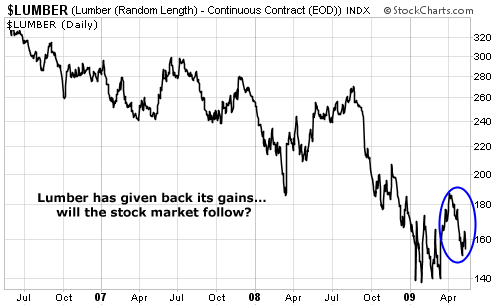| Home | About Us | Resources | Archive | Free Reports | Market Window |
This Indicator Holds the Key for InvestorsBy
Friday, May 15, 2009
To predict the stock market, I watch lumber...
To store lumber, you need a large climate-controlled warehouse with a railroad spur. Even then, it could still spoil within six months, destroying your entire investment. Because lumber loses its value quickly and it's expensive to store, the investment public at large does not participate in the lumber market. The costs are too high... The mills use "just-in-time" manufacturing principles to keep inventories to the bare minimum. By producing only what they can sell immediately, they avoid wastage. Lumber customers do the same thing. They only buy what they need that week. There is a lumber exchange in Chicago where you can trade lumber futures. It's a "professionals only" industrial matchmaking service. If you're a homebuilder and you need lumber for a current construction project, the lumber exchange works fine for you. But if you're an investor looking to hold lumber for a year or more, you'll get ripped off. First, you'll pay huge storage costs. The market builds these costs into the futures price. Second, there's almost zero trading volume once you get beyond the next three months, so you'll pay a massive premium for illiquidity. For example, right now, if you want to buy lumber into the future – say a contract that expires one year from now – you'll have to pay a 38% premium over the price of lumber delivered next week. These costs keep the riff-raff out of the market. This is why I love to watch lumber. The price of lumber is set entirely by commercial money responding to real business conditions. There's no public speculation to muddy the water and generate confusing signals. Take the 2008 credit crisis as an example. The lumber price was the first to signal a bear market was coming. It peaked in May 2004. The Bloomberg Homebuilders Index peaked in July 2005. The Case-Shiller U.S. home price index peaked in July 2006. The credit crunch started in February 2007, when New Century Financial collapsed. And finally, the S&P 500 peaked in October 2007. Here's a chart of lumber going back three years. As you can see, lumber bounced like everything else earlier this year, but has not been able to hold its gains.  I take this as a message from the homebuilders and the giant logging companies that the real estate market is getting worse again. And if that's the case, it might be time for stocks to take a breather, too... Good investing, Tom
Further Reading:
This Indicator Says Home Prices Are Nearing a Bottom Market NotesTHE STOCK MARKET CORRECTION IS HERE…
The stock market correction we warned you about last week is getting started...
Remember: Markets are like runners. They can't run flat-out for long before getting "winded." Rallies eventually stumble and shake off the latecomers. And baby, the stock market has rallied in the past two months. The benchmark S&P 500 is up a huge 33% since March 9. This super rally has left the stock market winded by any "internal" technical measure you can find. It also created a ton of optimistic people hoping for higher 401(k) values. The old trader's rule is that the market hurts as many people as it can as often as possible... so it's time to slam the hopers. Our colleague Jeff Clark just laid out the case for a severe correction soon. He points to the recent weakness in stock prices as a sign of more bearish things to come. Jeff is known as the "E.F. Hutton of trading" around the DailyWealth offices. When he speaks, we listen. You can read his latest thoughts free in this recent edition of the Growth Stock Wire. |
In The Daily Crux
Recent Articles
|

